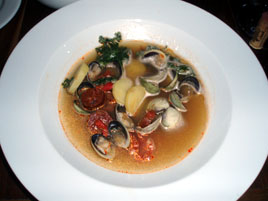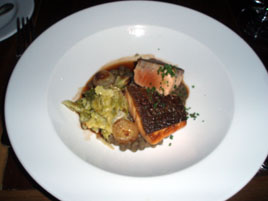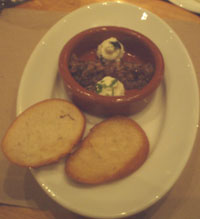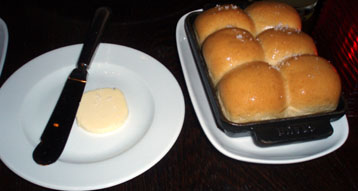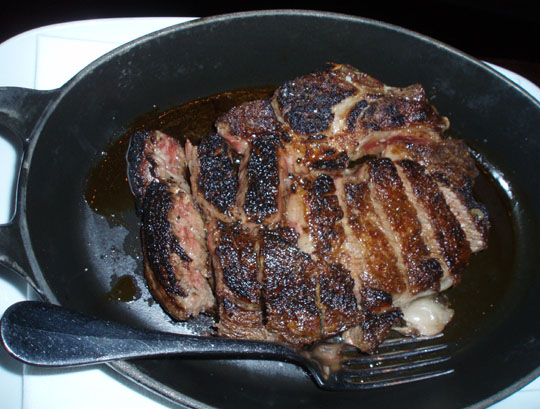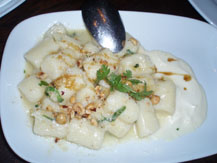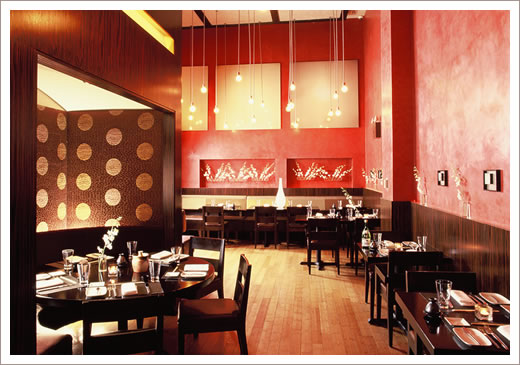
Note: Riingo closed in 2012. The space is now called Atrium, run by ESquared Hospitality, the same folks behind BLT Steak, BLT Prime, etc.
*
I overlooked Riingo when it opened almost four years ago in the Alex Hotel. My girlfriend is a fan of the chef/owner, Marcus Samuelsson, who also runs the Swedish restaurant Aquavit, so I figured a visit was past due.
The restaurant is Samuelsson’s take on Asian Fusion, which was no longer a new concept when Riingo opened. It garnered mixed reviews: Amanda Hesser delivered a two-star rave in the Times, but Adam Platt in New York (in his pre-star system days) was less impressed.
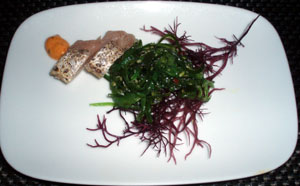
Amuse-bouche: Mystery Mackerel
It’s possible to see why Hesser liked the place, as everything we tried had potential. But alas, the execution was truly incompetent, and it was coupled with some of the most bumbling service we’ve seen in a long time.
The menu offers the standard appetizers ($5–14), salads ($10–16), entrées ($23–32) and side dishes ($5–6), along with a Japanese menu offering sushi, sashimi, and rolls. All the categories have an eclectic mix, so “tuna foie gras” appears on the sushi menu, and the entrées accommodate interlopers like steak frites. As it is located in a hotel, Riingo also serves breakfast and lunch, along with weekend brunch.
The room is decked out in the expected style, but the rear dining room, in which we were seated, is surprisingly cramped, and servers struggled to negotiate the space. The host made the odd comment that we had the best seats in the house. Our small table with overlapping placemats seemed like nothing of the kind.
The amuse-bouche seemed to be mackerel something-or-other; the explanation was inaudible. The bread service included stale rolls and something much better: a spicy ruffly potato-chip like substance along with a guacamole-like dip (all offered without explanation). As the server took the amuse plates away, he put our dirty forks back on the placemats, as one would do at a cheap diner. They can’t afford clean forks?
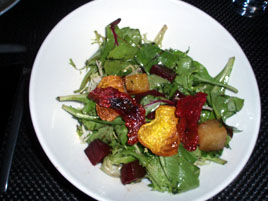
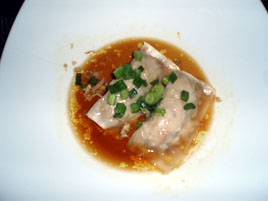
Don’t adjust your television set: Roasted Beet Salad ($12; above left) came in an odd-shaped bowl that tilted slightly to the right. The kitchen forgot the goat cheese that was supposed to come with it. The chicken that was supposed to be in Chicken Dumplings ($10; above right) was scarcely a rumor, as it was overwhelmed by a sour broth.
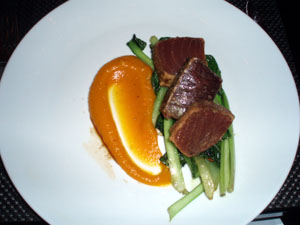 There was no false advertising about Rare Tuna ($26; left). As you can see in the photo, it’s as rare as can be, but the accompanying pumpkin purée was lukewarm and tasteless. Bok choy was warm, but had been left in the steamer too long.
There was no false advertising about Rare Tuna ($26; left). As you can see in the photo, it’s as rare as can be, but the accompanying pumpkin purée was lukewarm and tasteless. Bok choy was warm, but had been left in the steamer too long.
My girlfriend had the Chili-Roasted Chicken ($23), which was dry from over-cooking.
We ordered wine along with our food. When I pointed to the item I wanted, the server asked, “By the bottle?” I thought this was peculiar, as the menu didn’t indicate that it was available by the glass.
Matters only got stranger, as half-an-hour (and our appetizers) came and went, but no wine appeared. When it finally came, the server muttered that they had trouble locating my selection in the cellar. By that time we no longer wanted it, so I asked for two glasses; naturally, that wine wasn’t available by the glass, so I substituted an undistinguished pinot noir.
The couple at the next table overheard us, and mentioned that their wine too had not arrived until after the appetizers. We started watching the dining room, and sure enough, at least two other tables had the same experience, with wine delivered after—and in at least one case, long after—the appetizers had been served, consumed, and taken away.
For the usual petits-fours, Riingo had a couple of small oatmeal cookies, which naturally were stale. Perhaps Riingo was once a fine restaurant, but the kitchen and serving staff are have become sloppy, veering on incompetent. I can only hope that Samuelsson will rattle the trees, fire a few people, and get this restaurant back on track.
Riingo (205 E. 45th Street, east of Third Avenue, East Midtown)
Food: mediocre
Service: sloppy
Ambiance: acceptable
Overall: sad
 Tuesday, December 4, 2007 at 10:46AM
Tuesday, December 4, 2007 at 10:46AM  Gray Kunz,
Gray Kunz,  Grayz in
Grayz in  BruniBetting
BruniBetting 







